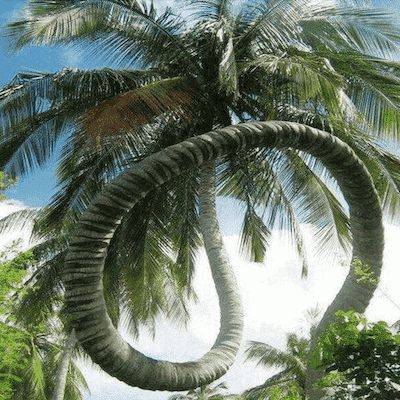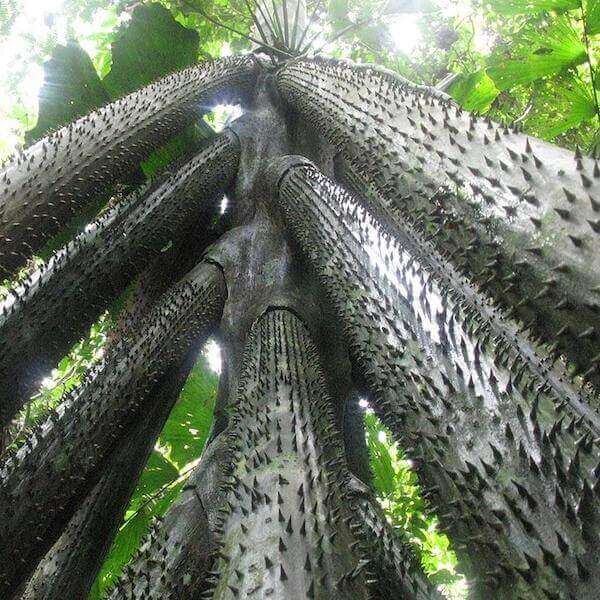Softwoods
A forest is a carbon bank, every tree a deposit.
With approximately 2,800 species, palm trees thrive in tropical, subtropical, and frost-free temperate regions worldwide. They are cultivated commercially for their fruits and play a significant role in enhancing the beauty of landscapes. Dating back 60 million years in the fossil record, these ancient plants were instrumental in human migration from the Middle East to Europe.
Palm trees are neither hardwood nor softwood. In fact, palm trees are not technically trees but are classified as grasses, similar to sugarcane, bamboo, corn, and rice. As a result, they do not produce traditional wood. However, a pioneering Japanese scientist developed a process to transform soft palm trunks into a hard, dense, wood-like material.
Palm wood is produced by compressing stalk-like fibers under pressure into dense blocks, which can then be milled into dimensional lumber, similar to hardwood or softwood sawlogs. The level of pressure applied during the process affects the color of the wood: higher pressure results in a darker color. For instance, Red Palm, a tradename for a type of palm wood, is lighter in color and only half as dense as Black Palm.
While palm wood lacks significant structural strength, it remains versatile, finding applications in crafting natural, organic products such as utensils, bowls, cups, woven furniture, and sun hats.
Around the globe, efforts are underway to combat desertification, a process that now affects one-third of the world's population. In China, a massive initiative is focused on halting the expansion of deserts, particularly in the west, where the largest transformation of productive land into desert is taking place.
In Africa, a cooperative project involving multiple nations is creating a "green wall" of trees stretching across the continent. This ambitious initiative aims to slow the relentless advance of desert sands, which consume 100 acres of new land daily. Upon completion, this green wall will be the largest living structure on Earth, visible even from space.
In the Middle East, the UAE is addressing desertification by planting a wall of trees along its borders.
It has worked before. In 1935, overgrazing and drought caused 850 million tons of topsoil to blow off the United States' southern plains, leaving 4 million acres barren and creating the Dust Bowl. To address the problem, the newly formed Soil Conservation Service introduced the Shelterbelt Project—a 100-mile-wide strip of native trees stretching from Canada to Texas. In just a few years, it reduced airborne soil by 60%.
Planting a wide wall of 12 to 15-foot tree saplings with well-developed root systems, grown using advanced propagation technology, could be even more effective against the frequent layering of windblown sands in desert environments.
Palm trees, particularly date palms, are highly effective in slowing the blowing sands of the desert. Date palms serve a dual purpose: as native trees, they grow quickly to provide shade and, at the same time, they supply a vital food source. Additionally, these remarkable trees contribute to combating climate change by capturing carbon. An acre of date palms can sequester approximately 10 tons of carbon annually, comparable to many temperate hardwoods.
How Palm Trees Capture and Store Carbon:
Date palms are often referred to as the "tree of life" due to their profound cultural, economic, and practical significance. They are considered the oldest fruit-bearing trees on Earth. Here’s why they’ve earned this title:
Food: Palm trees provide edible fruits, seeds, and sap, staples in many cuisines.
Shelter: Palm leaves are used for thatch roofs, offering protection from sun and rain.
Medicine: Oils and saps derived from palms are used in traditional remedies.
Spiritual significance: Palm trees have been used in various religious and spiritual practices for centuries. In some cultures, palm trees are considered sacred and are associated with concepts such as fertility, rebirth, and eternal life.
Economic value: Palm trees are an important economic resource in many parts of the world. For example, the oil palm is a major source of edible oil, while the coconut palm is used to produce a variety of products, including coconut oil, milk, and water.
There are some species of palm trees that are able to thrive in temperate climates, which are generally characterized by mild to cool temperatures and seasonal changes. These types of palms are sometimes referred to as "hardy palms" or "cold-hardy palms". Some examples of palms that can tolerate colder temperatures include:
Palms, separated by vast oceans and continents, evolved into some truly remarkable varieties. For example, the Coco de mer boasts the largest seed of any palm, measuring up to 20 inches across. On the other hand, the Wax palm, Colombia’s national tree, is the tallest palm in the world, towering over 300 feet.
Two thousand years ago, dense groves of ancient date palms thrived in the Jordan River valley until the Romans decreed their destruction. Thought to be lost to history, the species was rediscovered when seeds of the Judean Date Palm were found in a 2,000-year-old food store at Masada, a mountaintop fortress overlooking the Dead Sea. Against all odds, one of the seeds germinated, setting a record as the oldest stored seed to grow into a plant. As the trees begin to bear fruit, there is growing interest in reintroducing this ancient palm throughout the region.
Palm oil has medicinal properties, often used as an anti-inflammatory and antihistamine. Extracts of palm oil are commonly prescribed for colds and symptoms such as sore throats and chest infections. Dates, which are a related product of the oil palm ecosystem, are rich in vitamins B1, B2, B3, B5, A, and C, as well as fiber, calcium, iron, phosphorus, sulfur, potassium, copper, magnesium, and manganese. They are best consumed raw, either fresh or dried, and should not be cooked or processed to retain their nutritional value.
Derived from the fruit of the oil palm tree (scientifically known as Elaeis guineensis), palm oil is native to West and Southwest Africa. However, it is now cultivated in tropical regions worldwide, including Southeast Asia, South America, and parts of Africa. The oil palm tree is remarkably productive, yielding up to ten times more oil per acre compared to other oil crops, making it an efficient source of vegetable oil. Palm oil is widely used in various products, from cooking oil and margarine to soap, cosmetics, and biofuels.
An innovative project in the Middle East is transforming a portion of the Oman desert into a “green dot.” This thousand-acre initiative includes the cultivation of thousands of date palms, which not only produce fruit but also sequester significant amounts of carbon from the atmosphere. A 3-mile-long covered archway shields the project from desert sands while enclosing a circular river for fish farming and a 25-mile-long row dedicated to vegetable cultivation, creating a sustainable and productive oasis.
Partner with us in a land management project to repurpose agricultural lands into appreciating tree assets. We have partnered with growingtogive.org, a 501c3 nonprofit, to create tree planting partnerships with land donors.
We have partnered with growingtogive.org, a Washington State nonprofit to create a land and tree partnership program that repurposes agricultural land into appreciating tree assets.
The program utilizes privately owned land to plant trees that would benefit both the landowner and the environment.
If you have 100 acres or more of flat, fallow farmland and would like to plant trees, then we would like to talk to you. There are no costs to enter the program. You own the land; you own the trees we plant for free and there are no restrictions; you can sell or transfer the land with the trees anytime.
Copyright © All rights reserved Tree Plantation


